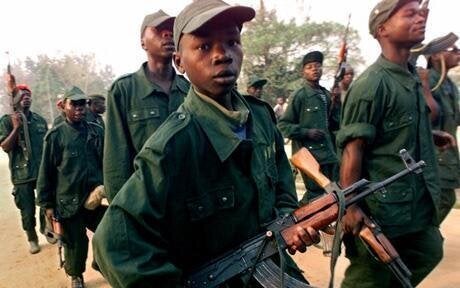
It isn't easy to translate the horror (and thrill) of being a child soldier on film, and Jean-Stephane Sauvaire does it masterfully, in his new film Johnny Mad Dog, recently screened at the Istanbul International Film Festival. From beginning to end, the audience is riveted by the shots of high-energy youth chanting war-cries, wielding AK47s, gang-raping a woman broadcaster, and cruising into towns on jeeps, waving their arms like one many-tentacled monster.
But what makes the film exceptional is that throughout the exacting violence, one senses the humanity of both victims and perpetrators.
First, Sauvaire had the original idea of having each child soldier have a distinct identity, from the charismatic Johnny Mad Dog to a boy known as Butterfly, who wears a pair of angelic white wings. One child soldier always wears a long creamy wedding dress.
"This is actually the case in Liberia," Sauvaire told me, as we sat on a stone ledge at he American Consulate Residence in Istanbul, overlooking the bay, at dusk, while wine glasses chinked gently around us. "The particularity of Liberian child soldiers is that some are given costumes, as part of their new military identity."
Flashes of human affection also mark the film -- a child soldier falls in love; a thirteen year old girl pushes her wounded father across town in a cart to save him.
"I added some of these more human moments myself," explained the director. "To give this emphasis." The movie is based on the eponymous book by Emmanuel Dongala, a Congolese chemist, and basically keeps the two basic story lines of Johnny Mad Dog and the thirteen year old girl.
I asked how it was possible that the director transcribed so well -- in accurate visceral detail -- what the experience of child soldiers must be like: the group mania, the drug-use, the numbed emotions, the rituals -- all that I had heard myself from child soldiers in Uganda.
The key lies in the "docu-fiction" approach. The actors, it turned out, are not actors, but escaped child soldiers. The director worked with them for a year in rehearsals in Liberia. Each child would improvise on the script, adding his or her own experience and authentic dialogue.
The result is breathtakingly real.
"I also used long-takes, so my camera does not interfere with or manipulate the image."
The director's commitment to these children -- both on-screen and off -- is evident, both in his craft and action: proceeds from the film will be used to help the child soldier actors rehabilitate themselves. As is the case with most child soldiers, their greatest problem is not what happens to them in the army, but when they get out: they are outcasts in society, illiterate and untrained, with no future.
The director -- whose previous projects include a documentary on the Colombian poor and who shared that his interest in the pains of violent childhoods comes from his own experience -- added that eventually he would like to interface with corporations and foundations to help -- on a wider scale -- former child soldiers build new lives, not just the fifteen he is helping now.
The last shot of the film: the sweet thirteen year old turns violent. A universal message of how easily innocence can be damaged, reminiscent of the ending shot of "Four Hundred Blows."
Highly recommended.

